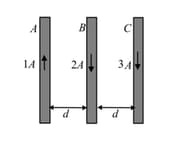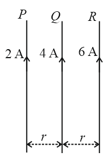EASY
NEET
IMPORTANT
Earn 100
Three long straight wires and are carrying currents as shown in the figure. The resultant force on is directed,


(a)towards .
(b)towards .
(c)perpendicular to the plane of paper and inward.
(d)perpendicular to the plane of paper and outward.
51.28% studentsanswered this correctly

Important Questions on Magnetic Effects of Current and Magnetism
MEDIUM
NEET
IMPORTANT
MEDIUM
NEET
IMPORTANT
and are long parallel straight wires in air carrying currents as shown. The direction of the resultant force on is,

EASY
NEET
IMPORTANT
EASY
NEET
IMPORTANT
EASY
NEET
IMPORTANT
EASY
NEET
IMPORTANT
EASY
NEET
IMPORTANT
MEDIUM
NEET
IMPORTANT
